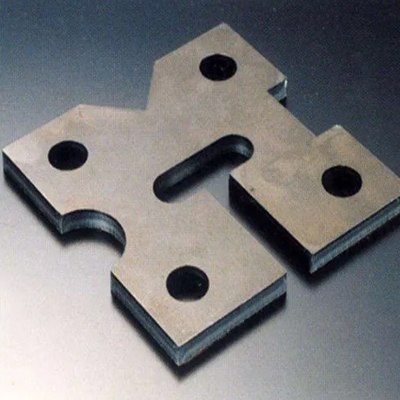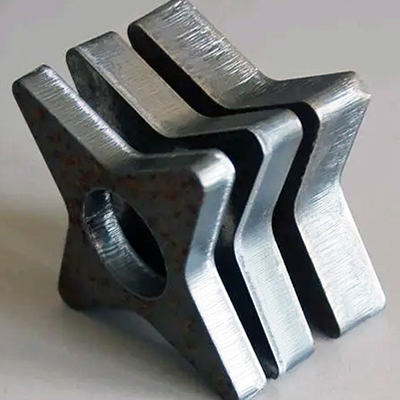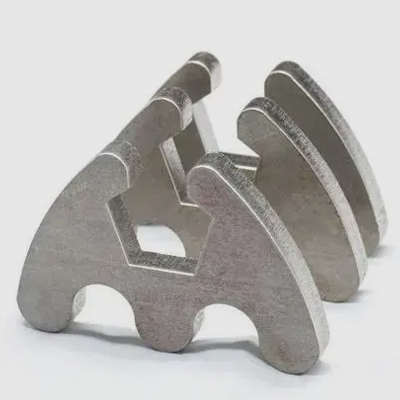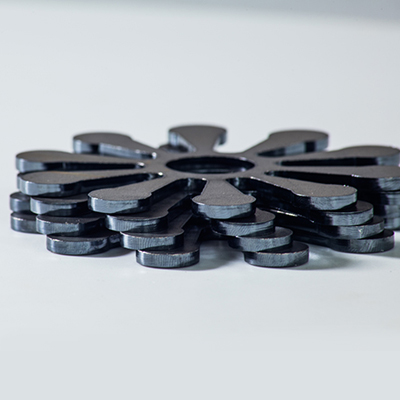| Applicable Metal Materials
Laser cutting technology can be used to process a wide range of metal materials, including but not limited to:

Stainless steel
With excellent corrosion resistance and strength characteristics, it is suitable for a wide range of industrial fields.
Suitable for thin and thick plate processing.

Carbon steel
Used in a wide range of applications, such as the machine building and construction industries.
Laser cutting enables high precision and high speed cutting.

Aluminum and its alloys
Lightweight and with good corrosion resistance, widely used in aerospace, automotive and electronics.
Cutting parameters need to be adjusted for the high thermal conductivity of aluminum.

Copper and its alloys
Widely used in electronic components due to good electrical conductivity.
Cutting is relatively difficult and is suitable for thin sheet cutting.

Nickel-based alloys
Commonly used in the manufacture of high-temperature resistant components, the laser excels in cutting these metals.
| Cutting Thickness Range
The applicable thickness of laser cutting varies depending on the type of material, and different cutting thicknesses can be realized with different powers of cutters:
Power | Carbon steel (mm) | Stainless steel (mm) | Aluminum (mm) | Brass (mm) |
| Ultimate thickness | Actual processing thickness | Ultimate thickness | Actual processing thickness | Ultimate thickness | Actual processing thickness | Ultimate thickness | Actual processing thickness |
1KW | 12 | 8 | 6 | 4 | 4 | 2 | 3 | 2 |
2KW | 16 | 10 | 8 | 6 | 6 | 4 | 6 | 4 |
3KW | 22 | 12 | 11 | 8 | 8 | 6 | 8 | 6(4) |
4KW | 25 | 14 | 12 | 10 | 10 | 8 | 10 | 8(5) |
6KW | 25 | 16 | 20 | 14 | 16 | 10 | 12 | 10 |
8KW | 40 | 20 | 30 | 18 | 30 | 16 | 16 | 12 |
12KW | 40 | 22 | 40 | 25 | 40 | 20 | 16 | 16 |
15KW | 60 | 25 | 50 | 30 | 50 | 25 | 20 | 18 |
The table above has listed the tables corresponding to different powers in detail (only for reference). Each material corresponds to the limit thickness and the actual processing thickness. Generally, the thickness of the cut processed by the factory in batches should be based on the actual processing thickness. This will not only guarantee the laser equipment service life and also ensure that the processed materials have good accuracy. If you encounter too thick a plate, you can also cut it, but it must not exceed the limit thickness. If cutting plates of extreme thickness in batches, after a long time, there will be certain errors in the materials, and the life of the laser will be shortened.
| Cutting Efficiency & Quality
The efficiency and quality of laser cutting are important indicators for evaluating its application in the metalworking industry, both of which have a direct impact on the economics of production and the quality of the finished product. Various aspects of cutting efficiency and cutting quality are described in detail below.
1. Cutting efficiency
Cutting efficiency is mainly related to the following factors:
● Cutting speed:
The speed of laser cutting usually depends on the power of the laser, the thickness and type of material. Higher power lasers can achieve faster cutting speeds.
Cutting speed varies from material to material, for example, carbon steel is usually cut at a higher speed than stainless steel and aluminum.
● Laser power:
Cutting efficiency is usually proportional to the output power of the laser. Higher power lasers can cut thicker materials in the same amount of time, increasing productivity.
Modern high power laser cutting machines (e.g. 3000W, 6000W and even 10000W) have been able to achieve fast and efficient cutting of thick plates.
● Material type:
Differences in heat reflectivity, thermal conductivity and melting point of different materials affect the efficiency of laser cutting. For example, aluminum has better thermal conductivity, which may lead to heat diffusion when cutting, reducing cutting speed.
● Cutting Technology:
The auxiliary gas used in the cutting process and the cutting method (e.g., pulsed mode, continuous mode, etc.) can also affect efficiency. Using the right auxiliary gas (oxygen, nitrogen, etc.) can improve cutting speed and quality.
● Degree of automation:
A highly automated laser cutting system can manage the production process more effectively, thus improving overall cutting efficiency.
2. Cutting quality
Cutting quality is another key indicator for assessing the effectiveness of laser cutting, mainly including the following aspects:
● Cutting accuracy:
Laser cutting machine can achieve very high positioning accuracy, usually within ± 0.1 mm error, which makes its performance in complex graphics and fine cutting is particularly outstanding.
The level of cutting accuracy also depends on factors such as the adjustment of the laser and the way the material is mounted.
● Cutting edge quality:
Laser cutting has a smooth cutting edge and usually requires no subsequent processing. The cut produces fewer burrs and the kerf has a high degree of perpendicularity and finish.
Different auxiliary gas choices and cutting parameters (e.g., focus position, cutting speed, etc.) directly affect edge quality.
● Heat affected zone (HAZ):
Heat propagation during the cutting process may affect the material properties in the cutting area, creating a heat affected zone. A smaller heat affected zone reduces material deformation and hardening, thus increasing the feasibility of subsequent processing.
Efficient laser cutting reduces this zone, thereby maintaining the physical properties of the material.
● Cutting shapes and complexity:
Laser cutting can easily handle complex geometries and subtle patterns, greatly expanding design possibilities.
For example, laser cutting can be utilized to achieve outstanding 3D effects or specially shaped parts.
● Post-processing needs:
A high-quality cutting surface not only reduces the time for post-processing grinding and treatment, but also reduces processing costs and improves overall productivity.
3. Parameters affecting cutting efficiency and quality
● Laser wavelength and focus:
Reasonable control of the laser wavelength and focus point position can optimize the cutting effect. Focus position is too high or too low will affect the cutting effect.
● Cutting speed and power ratio:
Reasonable setting of cutting speed and laser power ratio is very critical. Too fast a speed may lead to incomplete cutting, too slow may lead to the expansion of the heat-affected zone.
● Material thickness:
As the material thickness increases, the cutting time will increase accordingly, so there is a need to balance between thickness and processing efficiency.
● Operator experience:
Experienced operators are able to reasonably adjust parameters according to material properties, equipment status and cutting needs to achieve higher efficiency and quality.
In industrial production, laser cutting is widely used because of its high efficiency and high quality, which can meet the needs of various complex designs and mass production. By continuously optimizing the cutting parameters, improving the machine performance and increasing the operating experience, the efficiency and quality of cutting can be further improved, thus promoting the continuous development of the metal processing industry. Click here to contact Suntop Laser today to learn more about laser cutting.
| Cutting Processes
Laser cutting usually adopts gas-assisted cutting (such as oxygen and nitrogen) to improve the cutting effect:
1. Oxygen cutting
Applicable materials: mainly used for cutting carbon steel.
Working principle: In the cutting process, the laser beam heats up the surface of the material, and the auxiliary oxygen will react with the melted metal to form an oxidation reaction to release more heat. This process improves the cutting speed and gives better quality cuts.
Advantages:
Faster cutting speed: the combustion of oxygen generates additional heat and facilitates the cutting process.
High quality of cut: fewer burrs and melt drops, smooth surface.
Economical: Oxygen cost is relatively low and cutting efficiency is high.
Disadvantages:
Since the oxidation reaction may cause oxidation of the cutting edge, it is less suitable for applications that require higher surface quality after cutting.
2. Nitrogen cutting
Applicable materials: mainly used for cutting materials such as stainless steel and aluminum.
Working principle: In laser cutting, nitrogen is used as a protective gas to avoid material oxidation, and at the same time reduce the heat-affected zone and effectively control the thermal deformation of the edge.
Advantages:
Avoiding oxidation: the material will not affect the surface quality due to oxidation during the cutting process, which is suitable for high precision requirements.
Reduction of thermal influence: deformation and stress at the cutting edge are reduced by cooling action.
Adaptable: can be used for a wide range of metal materials, especially suitable for those applications that require high surface quality.
Disadvantages:
Relatively high cost, nitrogen supply adds some processing costs compared to oxygen.
When choosing gas-assisted cutting, it is necessary to reasonably choose oxygen or nitrogen as the auxiliary gas according to the nature of the material to be cut, the required cutting quality and economic considerations. Both have their applicable scenarios and advantages and disadvantages in order to realize the best cutting effect in the laser cutting process.























































